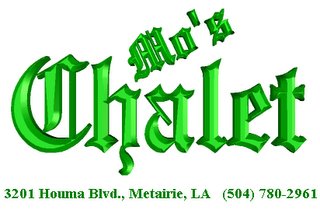A shrine to the sanctity of primeval enchantments, lasciviousness, and driving percussion that turn young human beings dancing machines. The music is of proletarian origins, that B-more Club sound. It dates back to "Doo Doo Brown" and "The Perculator" and has most recently derived most of its musical influences from motown and contemporary hip-hop tastes. The B-
 More Club DJs exhibit fervent devotion to the Supremes, the Marvalettes, and (Lil' Jon &) the East Side Boyz. Guys and girls grinding their gizmos together, all the while frollicking about to a throbbing backbeat and kick drums that propel your inner rhythm towards percussive paradise. . .
More Club DJs exhibit fervent devotion to the Supremes, the Marvalettes, and (Lil' Jon &) the East Side Boyz. Guys and girls grinding their gizmos together, all the while frollicking about to a throbbing backbeat and kick drums that propel your inner rhythm towards percussive paradise. . .Mo's was an escape from the confines of day-to-day anti-Mo life. The concept of Mo's, was for us, something that allowed savage displays of pelvis-to-pelvis art. B-More club music was the enabler.
Here's an article I wrote for the Baltimore Sun when I did news reporting in Baltimore County over the summer of 2002. This was the summer of White Trash Anthem and lots of Mo's recollecting. My middle-aged, bland editors did not agree to publish my story on B-More Club. They were too square. The Sun did not actually end up reporting on B-More club for another 3 years, when two halfway decent articles by guys who had clearly never actually lived the B-More Club experience got on the cover of the Sunday Arts & Society section. August 21, 2005, was the first time that the Sun allowed B-More club tales to grace its pages - three years, two weeks, and one day after I initially submitted my B-More club story. The version below is the first version of the story that I pushed to my editors. I made considerable changes to the piece three days later, on August 9, 2002, but the final version disappeared in the vast Sun story database, never to be found again.
Hooray Hooray to B-more Club! I'm planning a 20th Anniversary bash for B-More Club to be held June 14th, 2007. It'll be magnificent circus of Mo's memories and funky number sixty-nines.
Anyway, here's the text of my feature on B-More Club. Good night from the suburbs. Good morning to the tenements.
Shawn Caesar nonchalantly picks up the phone at his cluttered desk to call DJ Spice, one of many DJs signed with Unruly Productions. Shawn informs the affable DJ about an upcoming soiree at Club Choices, where club music will be the primary mode of entertainment. For these promoters, club music is a way of life.
Club music is an ill-defined term for a very Baltimore genre of music. Resoundingly percussive and primordial in spirirt, club music drives the nighttime scene in many Baltimore-area clubs. As an art form native to Baltimore, many locals see the quirky jams as cause for intense local pride.
"It's mesmerizing, the energy that it makes people exert is unbelievable," said DJ Spice, an Annapolis native who has played at most Baltimore-area nightclubs.
An American urban underground culture that has not been tarnished by the grip of international music conglomerates, club music has hundreds of thousands of listeners, according to Pork Chop, director of Club Queen Entertainment, Unrulys biggest competitor in the club music business.
When in Baltimore, the phrase club music does not just mean any type of music played in a club. It denotes Baltimore's unique form of house music. Basic, repetitive drum beats mixed with idiosyncratic sounds combine elements of the Golden Age of DCs go-go with Miami's bass music and Chicago's trax. DJs often sample popular rap songs by the likes of DMX and Ludacris. Also, the unusual breakbeat construction with 4-4 analog kick drums facilitates dancing in a "sexually provocative way," according to Pork Chop.
"If any other city tried to make this sound, we would know where they got it from," chuckled Pork Chop, who added that expansion into other East Coast cities is on the horizon for club music.
The most popular club music compilations are released by DJ Rod Lee, DJ Reggie Reg, K-Swift, and DJ Quicksilva, although these artists do not always produce the music.
"Rod Lee has recently become the pre-eminent creator of club music's signature Baltimore sound," said Shawn Caesar, Unruly's owner.
In the past, DJs relied on an Ensoniq sampling machine called the ASR 10 to compose club music. However, with the advent of convenient computer software, the creation process has become much simpler.
Many DJs borrow from the immense pool of existing club tracks when putting together albums or spinning at clubs. Thus, the licensing of club music tends to be ambiguous, according to DJ Spice.
Some critics assert that the music lacks aesthetic beauty and possesses solely entertainment value. DJ Spice answers that club music just provides a rhythm to let people shake their bodies.
"Men and women between the ages of 15 and 30 listen most to club music. I like the beat, it gets everyone dancing," said Kia Willis, a 21 year-old from East Baltimore who enjoys club music on Sundays at Hammerjacks. Kia believes that club music is the only way to excite a crowd of her peers.
Though the market for club music is predominantly black, white suburban kids are catching on, especially on the east side of Baltimore County. DJ Spice, who is white, estimated that half of all club music listeners in the Baltimore metro area are white.
"Its got huge crossover appeal," said DJ Spice of club music's ability to transcend racial boundaries.
Distribution of club music takes many forms, yet the most lucrative is through record sales, said Shawn Caesar, whose Unruly Productions has formed a marketing partnership with Downtown Locker Room. Club music also sells at Inner City Records, Metro II, and Sam Goody's.
"Club music gets its most exposure to the public through radio and clubs," said Caesar.
Club jams can be heard blaring out of soundsystems during rush hour Baltimore traffic, when 92.3 W-ERQ airs the hottest new tracks.
The new X-105.7 also has caught on with club music, with DJ Spice and DJ Quicksilva playing club music several nights per week.
"Two of my favorite recent club mixes sample oldies Ding-a-ling (from the Chuck Berry song) and Mr. Postman (from the Supremes song)," said DJ Spice. Another that has been popular is Latin Groove, which highlights an eccentric Brazilian samba sample.
In clubs, the music enables freaking, in which male dancers grind their pelvic regions into the posterior sections of females to the rhythmic bass sound. "The dancing allows for individualized style and improvisation," said DJ Spice, who has played at most Baltimore clubs, including Mo's Deep Six, Generation Xtremes, and Hammerjacks.
The infamously violent Tunnel night club on Eutaw St. is another place where club music defines the atmosphere.
Pork Chop, Club Queen's 29 year-old director who has lived club music since its genesis, said that the genre was incipient around 1987 in Baltimore clubs. He explains that the hypnotic, nocturnal music gradually rose from an experimental fad to a permanent and central aspect of Baltimore's musical landscape.
However, many promoters contend that club music has prevented a rap scene from establishing a solid foothold in Baltimore. DJ Spice said that virtually no nationally famous rappers have emerged because, rather than staging hip-hop shows in clubs, Baltimoreans prefer club music that they can dance to. Thus, though infectious and often witty, the audio-visceral club music competes for popularity with local underground hip-hop, suggested DJ Spice.
Nevertheless, the optimistic DJ is certain that club music has yet to reach its potential.
"In five years, Baltimore club music will be a format of music recognized in the mainstream. It will keep spreading like wildfire," said DJ Spice.




No comments:
Post a Comment